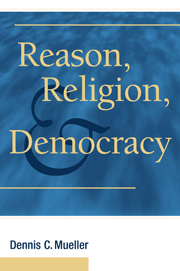Book contents
- Frontmatter
- Contents
- Preface
- 1 Liberal Democracy
- PART I FUNDAMENTALS: EVOLUTION, PSYCHOLOGY, REASONING, AND RELIGION
- PART II A HISTORICAL LOOK AT THE STATE, DEMOCRACY, AND RELIGION
- 4 The First States
- 5 Athens and Rome
- 6 The Caliphate
- 7 The Renaissance
- 8 The Enlightenment
- 9 Religion and Democracy After the French Revolution
- Epilogue to Part Two
- PART III THE INSTITUTIONS OF LIBERAL DEMOCRACY
- PART IV CHALLENGES TO LIBERAL DEMOCRACY
- References
- Author Index
- Subject Index
8 - The Enlightenment
Published online by Cambridge University Press: 05 June 2012
- Frontmatter
- Contents
- Preface
- 1 Liberal Democracy
- PART I FUNDAMENTALS: EVOLUTION, PSYCHOLOGY, REASONING, AND RELIGION
- PART II A HISTORICAL LOOK AT THE STATE, DEMOCRACY, AND RELIGION
- 4 The First States
- 5 Athens and Rome
- 6 The Caliphate
- 7 The Renaissance
- 8 The Enlightenment
- 9 Religion and Democracy After the French Revolution
- Epilogue to Part Two
- PART III THE INSTITUTIONS OF LIBERAL DEMOCRACY
- PART IV CHALLENGES TO LIBERAL DEMOCRACY
- References
- Author Index
- Subject Index
Summary
The sole foundation for the belief in the natural sciences is this idea, that the general laws directing the phenomena of the universe, known or unknown, are necessary and constant. Why should this principle be any less true for the development of the intellectual and moral faculties of man than for the other operations of nature?
(Marquis de Condorcet [1795]1955)During the Enlightenment (also called the Age of Reason), man's confidence in his ability to reason rose to heights not seen since the Ancient Greeks and arguably unsurpassed to this day. Although the term is typically used to describe eighteenth-century intellectual developments, the Enlightenment is largely an extension and expansion of seventeenth-century thinking. We begin, therefore, by reviewing some of the major intellectual developments of the seventeenth century.
Seventeenth-Century Foundations of the Enlightenment
Rationalism, Empiricism, and Scientific Methodology
During the Renaissance, the attention of scholars focused heavily on the humanities. By the middle of the sixteenth century, “the awakening” that demarcates the Renaissance had fully spread to the sciences. A Scientific Revolution began that continued through the seventeenth and eighteenth centuries, and it has continued more or less uninterrupted until the present day. We have already discussed the advances in astronomy by Kepler and Galileo at the beginning of the seventeenth century. In the life sciences, the major accomplishment was William Harvey's discovery of the circulation of blood (De Moto cordis et sanguinis, 1628).
- Type
- Chapter
- Information
- Reason, Religion, and Democracy , pp. 159 - 196Publisher: Cambridge University PressPrint publication year: 2009

